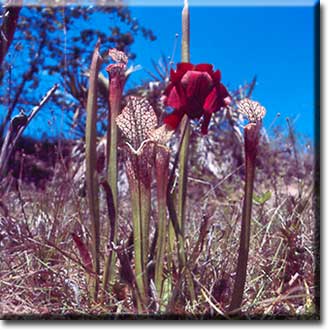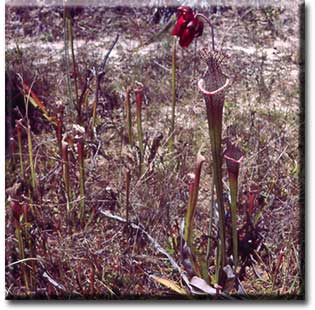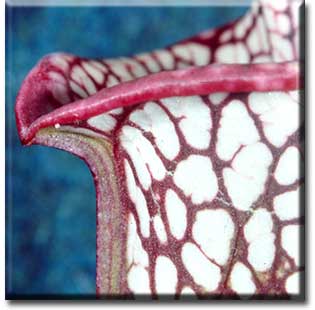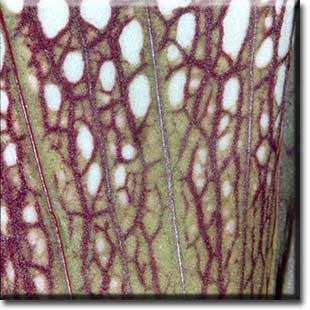Sarracenia leucophyllaCarnivorous Plants / Insectivorous Plants
Sarracenia leucophylla is easy to recognize because of its deep crimson flowers and the red-veined white tops of its pitcher leaves.
Sarracenia leucophylla is now classified as an endangered species. It grows on acid white sand areas that occur as openings among pine groves, along eastern Gulf Coast areas from Louisiana to the Florida panhandle. It occurs as plants with several leaves, not dense clusters of lines. The deep crimson flowers of Sarracenia leucophylla have large petals that hang downwards. Also show in this picture are a young unopened leaf, at left, a mature leaf next to the flower stalk; and a dying leaf, below at the left. The pitcher leaves of Sarracenia leucophylla are very narrow, gradually flaring upwards. The leaf at left is unopened. The leaf in the middle shows the lid overarching the throat of the pitcher. In many leaves, the lid has a diagonal or even upright position rather than overarching the pitcher throat. Notice in the center of the flower, there is a slightly lighter-colored umbrella-like structure surrounded by the petals. 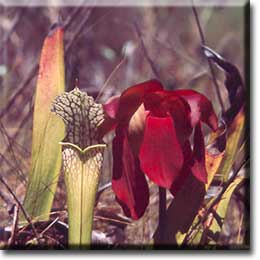 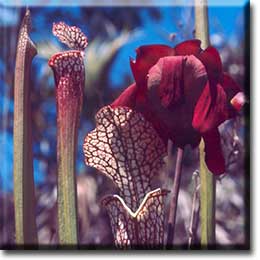 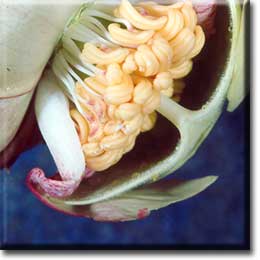
A section of a young flower of Sarracenia leucophylla. The numerous orange stamens are full of pollen. The umbrella-shaped stigma, one edge cut away here, is lined with small short hairs and drops of liquid. These hairs and liquid are involved in catching of the pollen grains. Each of the petals (not yet turned crimson here) curves around the edge of the umbrella-like stigma in an S-shaped fashion. An insect entering this flower must be large and strong enough to force back the petals and crawl in, thereby contacting the pollen or the stigma surfaces.
The throat of a Sarracenia leucophylla pitcher has a reddish shiny rim that evidently attracts insects, particularly in view of the whitish area of the pitcher leaf that contrast with it. The red-purple network pattern overlies the major veins in the leaf. At left is a purple and green wing-like structure that represents the fused margins of the leaf. A close-up of the outside of the pitcher leaf, near the throat. The white patterns probably are attractive to insects by their brightness. Green areas are also present. White and purple patterns decrease toward the bottom of the leaf, most of the tubular portion of which is green. Here's the lid of the pitcher of Saracenia leucophylla, showing the surface that overarches the throat. Notice the downward-pointing hairs. These hairs tend to make insects walk downward into the pitcher, preventing them from walking back upwards and out of the pitcher. Uniquely among insects, the Exyra moths that live in Sarracenia pitchers are not affected by the downwardly-pointing hairs on the inside of the pitchers. The Exyra moths spend their lives within the pitcher, feeding on the leaf tissues as caterpillars. 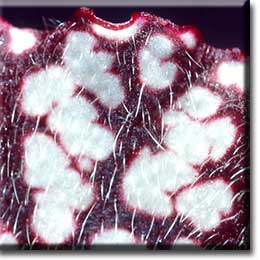 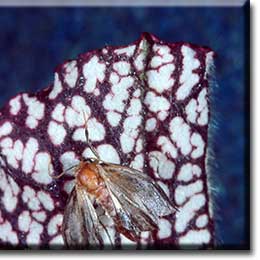 |
